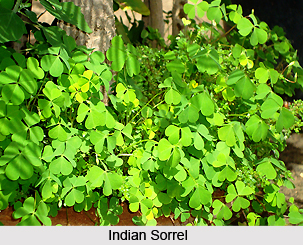Origin and Composition
Indian sorrel is a tiny, bushy, yearly herb. It has several branches which sprout out from the roots and mature to a length of 12 to 30 cm. The stem of the plant is extremely thin, soft and bushy. It has pale green compound leaves, with soft, very thin and polished leaflets. It also has yellow flowers and cylindrical fruits comprising numerous tiny seeds.
 The herb is native to India. Prospering in moist climate, it grows wild during monsoon and on swampy grounds. The flowers of the plant are bitter due to a high content of oxalic acid and potassium oxalate. The herb is rich in vitamin B, iron and calcium. The leaves contain a little amount of cellulose.
The herb is native to India. Prospering in moist climate, it grows wild during monsoon and on swampy grounds. The flowers of the plant are bitter due to a high content of oxalic acid and potassium oxalate. The herb is rich in vitamin B, iron and calcium. The leaves contain a little amount of cellulose.
Methods of usage
Indian sorrel largely covers every everyday disease, ranging from fever, stomach ailment, jaundice, skin eruptions, eye disorders, to insomnia.
Healing Power and Medicinal Properties of Indian sorrel
The leaves are acerbic, bitter and moderately astringent. It is predominantly acidic to taste. It is better to mix the herb with other balmier tasting herbs. The juice of 15 grams of this herb, blended with five grams of basil (tulsi) juice, may be had with 100 ml of raw coconut water. This raw juice can also be mixed with cooked greens. The leaves have a cooling sensation and act as an appetiser.
Fever cured by Indian sorrel
The leaves are useful in alleviating symptoms of fever. A concoction of the leaves can lessen rising temperature.
Scurvy cured by Indian sorrel
The leaves are anti-scorbutic and are useful in the prevention and treatment of scurvy - a deficiency caused by lack of vitamin C. A concoction of the leaves can be consumed for this purpose.
Stomach Disorders healed by Indian sorrel
Fresh leaves of the plant are useful in invigorating the stomach and assisting its action. The leaves can also be eaten as an appetiser. The leaves are advantageous in moderate cases of dysentery and enteritis. They should be boiled in buttermilk and given twice daily. Fresh juice of the leaves, blended with honey or sugar, is also useful in dysentery.
Jaundice healed by Indian sorrel
The herb is advantageous in the remedy for jaundice. A tablespoon of fresh juice mixed with buttermilk made of cow`s milk can be had once a day in the handling of this disease.
Excessive Thirst cured by Indian sorrel
Indian sorrel curbs too much thirst caused by diabetes or brutal heat. The same method of ingestion done in case of jaundice can be followed.
Skin Disorders healed by Indian sorrel
The leaves are useful in specific skin diseases like warts, corns and other excrescences of the skin. They can be locally administered in these conditions. The juice of the whole plant coalesced with onion is also massaged to get rid of warts. A poultice of the leaves applied over a swelling alleviates pain, and when applied over boils, ripens them to burst. The juice merged with black pepper and ghee, gives reprieve from red spots and eruptions on the skin caused by biliousness.
Eye Disorders healed by Indian sorrel
The herb is very helpful in debarment and treatment of eye disorders. A few drops of the leaf juice dropped into the eyes each day keeps the eyes free from strain and debars opacity of the cornea and cataract. The leaves are quite efficient, when administered locally for correcting the opacity of cornea.
Insomnia cured by Indian sorrel
The juice of the leaves mixed with castor oil is functional in cases of acute insomnia. The juice should be mixed in an equal quantity of castor oil and heated to take away the watery content. It should then be cooled and preserved in a bottle. When the scalp is massaged with this oil before going to sleep at night, it will hasten good sleep and also provide solace to the eyes.
Precautions - As the Indian sorrel comprises high density of oxalic acid, its use should be averted by people suffering from gout, rheumatism and calculi or stone in the urinary tract.



















